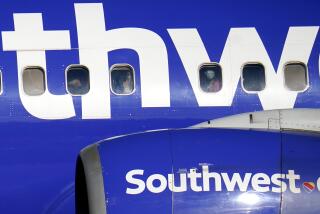When a Flight Is a Pain in the Back : Preventive tips are to pack extra pillows, move around the plane or fly first-class, especially when it comes with a massage.
- Share via
Fly far enough, especially in a cramped coach section, and you can end up looking and feeling like a pretzel. For those with a history of back problems, airline seats can trigger even more pain. Call it the “economy-class syndrome,” said Dr. Terri Rock, a Santa Monica family practitioner who specializes in travel medicine.
Traditional airplane seats can be tough on the back. They can alter the normal curvature of the spine and thrust the neck forward, said Dr. Santi Rao, a Los Angeles orthopedic surgeon and director of the Orthopaedic Hospital’s Spine Center. Sit long enough and you’re likely to feel pain, especially in your lower back.
But comfort is becoming a hot commodity, now touted almost as heavily as bargain summer fares. Legroom is in, as more carriers increase the space between seats, often referred to as “pitch.” Some carriers are adding footrests, at least to first-class and business-class sections. And one airline has a massage therapist who delivers back and neck massages to passengers on flights between Los Angeles and London.
TWA recently increased the distance between seats in coach from 31 to 35 inches. Continental Airlines has reconfigured its business-class sections with 55 inches between seats. The upper-class service from Virgin Atlantic Airways also has 55 inches between seats; the mid-class seats are 38 inches apart.
Footrests are increasingly common. TWA wide-body flights, for example, will be equipped with footrests in all sections by the end of June, according to a spokesman. And American Airlines recently redesigned first- and business-class seats with built-in pillows in the lumbar area of the back, at the shoulder and at the head.
Footrests are a particularly good idea, Rock said. Using one “lengthens the lumbar spine and takes the pressure off the lower back. It also gets weight off the hamstring (back of thigh) muscles.”
Less common are free on-board massages, such as those found on some upper-class Virgin Atlantic flights between Los Angeles and London and New York and London. And at its lounge in London’s Heathrow Airport, the airline offers free, full-body massages for upper-class passengers.
But even if your seat has not been upgraded and there is no masseuse in sight, you can still do much to increase your comfort. If your seat doesn’t have a footrest, make your own, Rao advised. Place a briefcase or small suitcase horizontally under the seat in front of you and use it as a footrest.
If your seat doesn’t support your back comfortably, grab an airline pillow or two. Place the pillow or pillows behind the small of your back. The point, Rao said, is to re-create the spine’s natural curvature. Neck support can improve comfort, too.
Several manufacturers offer back and neck pillows small enough to tote. Among products available are the Posture Curve Lumbar Cushion, $25, and the Crescent Cervical Pillow, $21, from Body Care (800-858-9888). The Ergo Cushion is a chair cushion with a carrying handle for $35 from Backsaver Products (800-251- 2225). The Pocket Pillow, $12.85, has two inflatable chambers but folds up small, and the Hedbed, $9.95, also inflatable, provides neck support. Both are available from Magellan’s Essentials for the Traveler (800-962-4943).
There are other measures to take before, during and after a trip to minimize back discomfort. Among the experts’ suggestions:
* Buy good quality suitcases with rollers, advised Dr. Christopher Traughber, medical director of Immediate Medical Care Centers in Palos Verdes and San Pedro. Take two small and light suitcases, experts advise, rather than one large, heavy one. Choose a backpack-style rather than a shoulder bag tote, Rock advised.
* Passengers with a history of back pain should take along an emergency supply of prescription medications they have found useful in the past, Rock suggested, along with a hot-or-cold pack in case of injury.
* Do simple back exercises beginning a few days before a long airplane flight, Rao said, even if you have no history of back pain. Obtain a list of exercises from your doctor, physical therapist or a self-help back care book. * Push your seat-recline button as soon as you can, Rao said. “That takes some of the stress off the spine.”
* Move around on the flight as much as possible. “Get up and move every two hours,” advised Traughber. And don’t sit on a bulky wallet, Rock added. It can put pressure on the sciatic nerve and lead to pain around the buttocks and lower limbs.
* Watch your body mechanics at the luggage carousels, added Traughber. He said luggage retrieval is a setup for back injury because it requires simultaneous lifting and rotating, often done in a hurry.
More to Read
Sign up for The Wild
We’ll help you find the best places to hike, bike and run, as well as the perfect silent spots for meditation and yoga.
You may occasionally receive promotional content from the Los Angeles Times.






